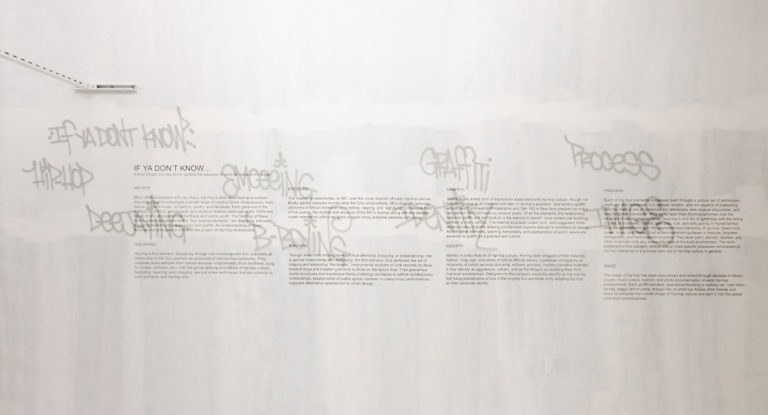Table of Contents
If Ya Don’t Know…
A brief insight into key terms guiding the selection of work for Close to the Edge.
Hip-Hop
Most often associated with rap music, hip-hop is best described as a cultural movement that encompasses a broad range of creative forms of expression, from dance, art, and music, to fashion, poetry, and literature. Each grew out of the political, economic, sociological, and physical realities particular to the 1970s-era South Bronx as experienced by Black and Latino youth. The first four of these forms, widely recognized as the “four original elements,” are deejaying, emceeing, b-boying (breaking/breakdancing), and graffiti. An understanding of these foundational principles is critical to the project of Hip-Hop Architecture.
Deejaying
Hip-hop’s first element, deejaying, though not chronologically first, precedes all others due to the DJ’s position as conductor of the hip-hop symphony. They compose audio samples from various sources—vinyl records, drum machines, kung fu movies, cartoons, etc.—into the genre-defining soundtrack of hip-hop culture. Sampling, layering, and collaging are just a few techniques that are common to both architects and hip-hop DJs.
Emceeing
The master of ceremonies, or MC, was the vocal director of early hip-hop parties. Boldly adding complex rhymes atop the DJ’s compositions, MCs draw on centuries-old forms of African American story-telling, rapping, and “signifying”—a freestyle form of live poetry. The rhythm and structure of the MC’s rhymes, along with the densely coded references within rap lyrics, suggest many potential parallels with design.
B-boying
Though listed third among hip-hop’s four elements, b-boying, or breakdancing, has a special relationship with deejaying, the first element. DJs perfected the art of looping and extending “the breaks” (instrumental sections of funk records) to allow breaker-boys and breaker-girls time to shine on the dance floor. Their precarious bodily structures and expressive forms challenge architects to rethink building-body relationships. Appropriation of public space, common in many b-boy performances, suggests alternative approaches to urban design.
Graffiti
Though not fully recognized as an element until later in hip-hop's evolution, graffiti is the oldest form of expression associated with hip-hop culture. Graf writers (graffiti artists) like Cornbread in Philadelphia and Taki 183 in New York predate hip-hop’s recognized 1973 birthdate—when DJ Kool Herc hosted his first party at 1520 Sedgwick Avenue in the Bronx— by several years. Of all the elements, the relationship between graffiti and architecture is the easiest to discern since writers use buildings as their primary canvas. The internal structure, coded form, and suggested three-dimensionality of graffiti lettering are the main aspects relevant to architectural design. As with other elements, layering, temporality, and appropriation of public space are essential to graffiti as a practice and culture.
Identity
Identity is a key feature of hip-hop culture. Having been stripped of their histories, names, language, and sense of self as African slaves, Caribbean immigrants, or recipients of public services (housing, schools, prisons), hip-hop pioneers invented a new identity as aggressive, defiant, and as flamboyant as anything New York had ever experienced. Designers in this category explicitly identify as hip-hop by first being practitioners of one of the original four elements or by adopting hip-hop as their personal identity.
Process
Each of the four elements expresses itself through a unique set of techniques, methods, and processes. DJs sample, scratch, and mix aspects of preexisting sounds, making use of contemporary references, rare musical discoveries, and long-forgotten standards. MCs deftly layer their rhyming schemes over the structure of pre-engineered beats, weaving in and out of synchrony with the timing of bars. B-boys twist, contort, spin, pop, lock, and defy gravity in a myriad formal styles, each conforming to the predetermined hierarchy of up-rock, down-rock, power move, and freeze. Graf writers transform surfaces in obscure, forgotten, disregarded, and hard-to-reach locations. They layer paint, stencils, stickers, and other materials onto any accessible face of the built environment. The work presented in this category reflects one or more specific processes reminiscent of the four elements or a process born out of hip-hop culture in general.
Image
The image of hip-hop has been popularized and reified through decades of album covers, music videos, fashion, and photo documentation of early hip-hop environments. Each graffiti-bombed abandoned building or subway car, rope chain, do-rag, baggy denim jeans, Kangol hat, or shell-top Adidas shoe frames and helps to compose the overall image of hip-hop culture and burn it into the global collective consciousness.
